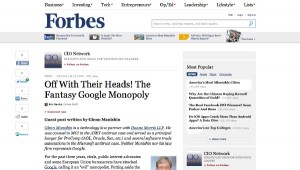A sample text widget
Etiam pulvinar consectetur dolor sed malesuada. Ut convallis
euismod dolor nec pretium. Nunc ut tristique massa.
Nam sodales mi vitae dolor ullamcorper et vulputate enim accumsan.
Morbi orci magna, tincidunt vitae molestie nec, molestie at mi. Nulla nulla lorem,
suscipit in posuere in, interdum non magna.
|

One year ago, the Wall Street Journal and other business publications reported that the Federal Trade Commission (FTC) had launched an investigation into “Twitter and the way it deals with the companies building applications and services for its platform.” The gist of the apparent competitive concern was that Twitter — which has grown from nothing to a significant new medium of social communications in just five years — had decided to limit access to its application programming interfaces (APIs) for third-parties, such as HootSuite, Echofon and the like, selling Twitter “client” software.
There’s no doubt Twitter is a disruptive technology. Of course, in 2000 the FTC was so convinced that an AOL-Time Warner combination would monopolize Internet content that it saddled the then-biggest merger with an onerous consent decree that evaporated, as did AOL itself, in the relative blink of an eye. Now it appears the agency is making the same mistake again. Assuming that a new and evolving technology represents a stand-alone market for antitrust purpose is dangerous where disruptive entrants are concerned, because as AOL illustrates, despite a first-mover advantage, even in network effects markets that may “tip” to a single firm competitive reality changes more quickly and in ways even the brightest pundits and government policy makers could never predict.
 Given that Twitter is in competition with Facebook, LinkedIn, Tumblr, Pinterest, Instgram and many other social networking and messaging services, including the near-moribund Google+, you’ve got to wonder why the FTC could even plausibly hypothesize that Twitter has anything approaching monopoly power. One can perhaps understand policy neophytes like Mike Arrington naively saying that Twitter has a “microblogging monopoly,” but not seasoned antitrusters. Given that Twitter is in competition with Facebook, LinkedIn, Tumblr, Pinterest, Instgram and many other social networking and messaging services, including the near-moribund Google+, you’ve got to wonder why the FTC could even plausibly hypothesize that Twitter has anything approaching monopoly power. One can perhaps understand policy neophytes like Mike Arrington naively saying that Twitter has a “microblogging monopoly,” but not seasoned antitrusters.
Twitter management explained at the time that “Twitter is a network, and its network effects are driven by users seeing and contributing to the network’s conversations. We need to ensure users can interact with Twitter the same way everywhere.” That’s a quintessential business judgment by corporate managers who presumably know their users (tweeters) and customers (advertisers) best. The company’s motivation is also clear and perfectly valid: it doesn’t want third parties making money — namely, coming into direct rivalry by selling ads — off its service, and thus depriving Twitter of potential revenue. It is incontestable that Twitter could vertically integrate into the client software business itself (a first step in which it did by acquiring TweetDeck), without any possible antitrust constraints. In this light, what could conceivably be wrong with Twitter setting ground rules that require third-party providers to utilize a common user interface (UI) scheme?
As Adam Thierer of the Technology Liberation front observed in 2011:
This episode again reflects the short-term, static snapshot thinking we all too often see at work in debates over media and technology policy. That is, many cyber-worrywarts are prone to taking snapshots of market activity and suggesting that temporary patterns are permanent disasters requiring immediate correction. Of course, a more dynamic view of progress and competition holds that “market failures” and “code failures” are ultimately better addressed by voluntary, spontaneous, bottom-up responses than by coercive, top-down approaches
Ironically, the Twitter decision to control API usage and effectively boot off some third-party software had only one economic effect. It cannibalized Twitter’s own developer and partner ecosystem, on which the company had relied heavily through its first years of extraordinarily rapid growth, in favor of an internal solution. That decision alienated some Twitter users and almost certainly reduced the absolute number of tweets sent and received — and thus the page views on which Twitter’s advertising rates are necessarily based. It also risked alienating the venture capitalists who have invested an estimated $475 million over just one-half of a year in companies working to develop Twitter-compatible apps and utilities. So the only firm Twitter is really hurting by this practice is Twitter itself. Eating your own ecosystem is hardly the stuff of monopolization.
Sacrificing independent distribution in favor of vertical integration is also a business model companies adopt and reject like roller coasters. In the oil industry, for instance, the most famous government antitrust case of them all is 1911’s Standard Oil, which broke up the vertically integrated petroleum monopoly assembled by John D. Rockefeller. Today, Standard’s offspring are rapidly disintegrating, divesting both wholesale distribution of refined oil products and retail gasoline dealerships. Sometimes conventional business wisdom extols vertical integration, other times it emphasizes an Adam Smith-type comparative advantage. But isn’t that the essence of marketplace competition? And in turn isn’t that something our nation’s competition policy should leave in the hands of market participants rather than government agencies?
The answer from Forbes is a simple yes:
If the FTC is indeed investigating Twitter, they are likely to find this case pretty boring. In acquiring the third party apps widely adopted by its users, Twitter is simply making a gradual, not to mention inevitable, move closer to its customer base. The startup is often slammed for its struggle to adopt a serious business model. Now that Twitter has finally figured out it is awfully difficult to build a business as a plumbing conduit, suddenly it’s lambasted as the next Microsoft.
In fact, the issue here is far more significant for technologies down the road that no one has as yet even conceived. Twitter seems sufficiently well-established that it will likely survive an FTC investigation, at least in the short run, and however misguided the government’s underlying assumptions may be. But start-ups which have not yet escaped from private betas and coders’ college dorm rooms will give pause, as they grow, before deciding to sever relations with partners  that helped them “get big fast.” The fear is that cutting off downstream firms, even if taken for objectively valid business reasons, will catalyze an FTC or European Union antitrust investigation of whether the firm has “abused” its “market dominance.” that helped them “get big fast.” The fear is that cutting off downstream firms, even if taken for objectively valid business reasons, will catalyze an FTC or European Union antitrust investigation of whether the firm has “abused” its “market dominance.”
A threat of government action can be just as debilitating to innovation as premature enforcement intervention into the marketplace. Let’s hope the FTC’s 2011 Twitter investigation is mothballed in 2012, and that in the future investigations of segment-leaders in nascent technology spaces are opened only where — unlike the case of Twitter — there’s clearly an economically valid market and practices involved which are unambiguously anticompetitive. The FTC has said nothing about the Twitter issue for a year, while the San Francisco Examiner revealingly comments that “[i]n the space of [that] year, the FTC has racked up more legal action involving the high tech world than the FCC and both houses of Congress combined.” Note to Chairman Leibowitz: it’s time to let this one go, now. If your agency wants to do that quietly in order to save face, no one in Silicon Valley will mind at all. We won’t tell.
Note: Originally prepared for and reposted with permission of the Disruptive Competition Project.

When Google’s proposed acquisition of Motorola Mobility was announced in 2011, the business press focused mainly on the extension of Google’s core business from Internet search into hardware. But from a legal perspective, the treatment given the deal by competition authorities in the United States, the EU and China raises intriguing questions about the scope and objectives of merger policy in emerging technology markets.
The acquisition represents a classic case of downstream vertical integration into complementary markets. Since Google’s aborted launch of its own “Nexus One” smartphone in 2010, Google’s presence in the wireless handset and other hardware markets has been minimal. Merger reviews typically focus on horizontal concentration in a relevant product market; namely, to evaluate the risk that an increase of concentration post-transaction may produce a rise in prices or other so-called “coordinated effects.” There has been virtual unanimity among antitrust scholars and enforcement authorities for several decades that vertical integration typically presents little or no antitrust risk.
That is a principal result of the Chicago School antitrust revolution, ushered into American antitrust law and policy by GTE Sylvania in 1977. Under this approach, vertical restrictions and other relationships between manufacturers, distributors and retailers are presumptively procompetitive by increasing incentives for interbrand competition. Although technically classified as a “rule of reason” analysis, in reality the leniency of American antitrust law to vertical restraints has been such that there are almost no significant examples (with a few exceptions, like the Microsoft monopolization case of 1998-2000) of vertical restraints or mergers being judged to violate the Clayton Act or the Sherman Act.
So it should come as little surprise, therefore, that from an antitrust perspective Google’s proposal to acquire Motorola Mobility raised very few eyebrows. Yet just weeks ago it was announced that Google had received final approval to close the deal from the new China Competition Authority (the Ministry of Commerce, Anti-Monopoly Bureau ), contingent on one important concession. The Chinese required that Google pledge to maintain its Android operating system (OS) on a free basis for all wireless device manufacturers for the next five years.
The evident competition concern here is behavioral, not structural. That is, there is no risk that post-merger, Google’s share of either its own markets or Motorola’s markets will exacerbate coordinated affects or give it enhanced unilateral market power. To the contrary, the competitive risk potentially feared by antitrust regulators or competitors is that once it has a presence in wireless device manufacturing, Google might favor its own financial and competitive interests downstream by beginning to charge device manufacturing rivals for the Android OS.
This presents two provocative issues. First, should merger enforcement policy be grounded in a prediction of the post-transaction business incentives of the merging parties? While merger analysis must necessarily be based on a prediction of future effects, projecting the future business behavior of any one firm is far more problematic and unreliable than the kind of structural market analysis informed by HHI and oligopoly economics. And in most if not all antitrust regimes, even if the merger itself is accorded clearance by competition authorities, governments and competitors still have the opportunity to challenge actual post-merger conduct as a violation of the antitrust laws. Especially in rapidly changing technology markets — of which wireless handsets are undoubtedly a leading example — the risk of error in basing merger policy on predictions of future business behavior seems rather high.
The second issue raised by Chinese approval of the Google-Motorola deal is whether antitrust enforcers can or should dictate price. Typically, it is assumed that antitrust policy relies upon marketplace competition to produce the most efficient allocation of resources and “correct” pricing. Even in per se illegal price-fixing cases, the government never independently decides what the “right” price should be, but rather steps in to redress cartels or other restraints that limit the ability of market forces to set price based upon supply and demand.
“Open source” software, however, seems to be an emerging exception to that settled rule. In Oracle’s 2009 acquisition of Sun Microsystems, competitive concerns were raised about whether Oracle might begin charging for Sun’s open source mySQL database software. In Google’s 2010 acquisition of ITA, a travel software developer, the U.S. Justice Department required as part of a consent decree settlement that Google agree to maintain ITA pricing to travel service rivals and to continue R&D for the software itself. While ITA represents proprietary, paid software, the same vertical pricing concerns animated the government’s response to that deal as well.
But who is to decide whether an OS, or any other software, must or should be offered for free? The business model case for open source — dating back to that pioneered by Netscape in the late 1990s, where the Web upstart offered its browsing software for free in order to capture share and profits from the sale of server software — has been that companies offer free products in order to monetize their investment at another level (typically upstream) of the distribution chain. Economics would therefore teach that, if as seems correct, Google could make more money from handset profits than licenses for its Android OS, its rational business incentives would be to maintain Android as a free, open source product.
There’s still a big difference between legacy command-and-control economies like China, despite its recent liberalizations, and the market-oriented economy of the United States. Yet with increasing globalization these sorts of conflicting world views are likely to become more prominent. Whether the OS wants to be free could become less important than whether some government or enforcement agency – probably not in the U.S., one hopes – makes it their job to supplant the marketplace and dictate the answer.
Note: Originally written for my law firm’s Information Intersection blog.


Today Forbes published an op-ed article I wrote on the antitrust furor surrounding Google. Here’s the concluding paragraph:
Google doesn’t act like a monopolist and shares none of the characteristics sheltering classic monopolists from competition. Its astounding success in Internet search is universally regarded as a consequence of better design, superior code, better products and plain old hard work. Like Lewis Carroll’s other queen, the Queen of Hearts, Google really has no power at all. Just as the Alice in Wonderland queen could majestically dictate “off with their heads” with absolutely no effect, Google must continue to run faster simply to stay in the same place. That’s not a monopoly; instead it is a success story that should be applauded.
Off With Their Heads! The Fantasy Google Monopoly | Forbes.

I’ll let my op-ed in Sunday’s San Jose Mercury News speak for itself. Opinion: In the Tech Industry, Small Isn’t Beautiful Anymore. Might be a little narcissistic to blog about one’s own article, no?
Wrangling over the proposed Google-Yahoo advertising deal makes one wonder whether scale, a virtue in Silicon Valley, can also be a vice. Some have insisted that Google is too big. But with apologies to economist E.F. Schumacher — author in 1973 of the generational anthem “Small Is Beautiful” — big isn’t bad anymore, it’s good.
A mere 10 years old, Google so dominates Internet search that the company’s name has become a verb. Google has grown large because it is good and its engineers continue to design innovative new products. That is something Web aficionados and antitrust regulators should applaud.
Google has already changed the way businesses advertise. The advertising issue is one its critics point to as evidence that Google is so large, the antitrust laws should kill the Google-Yahoo advertising venture before it launches later this month. The idea, as some ad agents have said, is that a combined Google-Yahoo share of “Internet search advertising inventory” would be competitively harmful. This is mushy reasoning being peddled to spread economic paranoia.
Everyone agrees that the principal objective of antitrust law is economic efficiency. To assess Google-Yahoo, therefore, one must first define what market we’re talking about. References to Internet search “inventory” are analytically dishonest, disguising the fact that search advertising — of which Google holds a 63 percent share — competes directly with Internet display advertising. Online display advertising is commanded by MySpace, AOL and Microsoft, and Google’s presence is tiny. As the data on rapidly declining advertising revenues for newspapers, network television and other “legacy” media reveal, Internet advertising is also becoming a substitute for advertiser dollars that used to flow elsewhere.
The consequence is that the relevant market cannot exclude Internet display advertising or even be limited to Internet advertising. And once the market covers something more than search ads, all serious competitive arguments against the Google-Yahoo transaction fade away. Take just a few.
Microsoft insists the alliance is unlawful price fixing because it will increase search advertising prices. To the contrary, neither Google nor Yahoo will be able to dictate minimum bids or prices to the other and, since advertisers will have a greater supply of more valuable search ads to buy — the demographically targeted ads produced with Google’s famously secret algorithms — the relative price for Internet search advertising will go down. That’s simple supply-and-demand, and it’s a good thing.
Others argue that Yahoo needs to remain independent and cannot be allowed into Google’s orbit. But this is not a merger or acquisition. If Yahoo’s board of directors, having just finished a bruising battle with Microsoft, violated its duty to maximize shareholder value, that is hardly the same as eliminating a competitor from the market.
Some suggest the government must act quickly to nip the growing power of Google in the bud. But in our market system we do not punish a successful company because it might do something bad in the future. Microsoft should be especially ashamed for endorsing this suggestion, since its decade-long antitrust fights here and in the EU arose from its bad acts, not its bigness. And unlike a merger, there can be no problem here of “unscrambling the egg” if things go south.
That leaves the only real objection to the Google-Yahoo! alliance as consumer privacy. There may be valid privacy objections to Google’s activities; indeed, Google might someday become so big that its possession of huge troves of personal data alone creates a threat to privacy. But as the FTC decided in approving the Google-DoubleClick merger in 2007, antitrust laws are not a substitute for privacy regulations.
So even here, privacy and bigness are not enemies. Unless Google starts acting badly in the competitive marketplace, the government should just leave it alone.
Glenn B. Manishin is an antitrust partner with Duane Morris in Washington, D.C. He was counsel for ProComp, CCIA and other software competitors challenging the Bush administration”s antitrust settlement with Microsoft. He wrote this article for the Mercury News.
|
|
 Given that Twitter is in competition with Facebook, LinkedIn, Tumblr, Pinterest, Instgram and many other social networking and messaging services, including the near-moribund Google+, you’ve got to wonder why the FTC could even plausibly hypothesize that Twitter has anything approaching monopoly power. One can perhaps understand policy neophytes like Mike Arrington naively saying that Twitter has a “microblogging monopoly,” but not seasoned antitrusters.
Given that Twitter is in competition with Facebook, LinkedIn, Tumblr, Pinterest, Instgram and many other social networking and messaging services, including the near-moribund Google+, you’ve got to wonder why the FTC could even plausibly hypothesize that Twitter has anything approaching monopoly power. One can perhaps understand policy neophytes like Mike Arrington naively saying that Twitter has a “microblogging monopoly,” but not seasoned antitrusters. that helped them “get big fast.” The fear is that cutting off downstream firms, even if taken for objectively valid business reasons, will catalyze an FTC or European Union antitrust investigation of whether the firm has “abused” its “market dominance.”
that helped them “get big fast.” The fear is that cutting off downstream firms, even if taken for objectively valid business reasons, will catalyze an FTC or European Union antitrust investigation of whether the firm has “abused” its “market dominance.”



